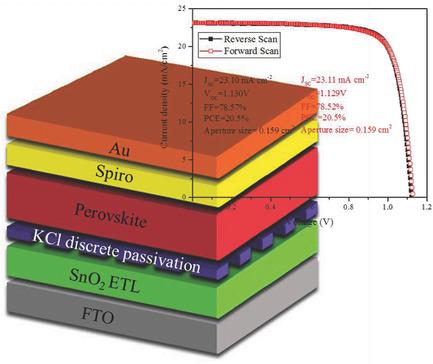当前位置:
X-MOL 学术
›
Adv. Energy Mater.
›
论文详情
Our official English website, www.x-mol.net, welcomes your feedback! (Note: you will need to create a separate account there.)
Exploring Inorganic Binary Alkaline Halide to Passivate Defects in Low‐Temperature‐Processed Planar‐Structure Hybrid Perovskite Solar Cells
Advanced Energy Materials ( IF 27.8 ) Pub Date : 2018-04-16 , DOI: 10.1002/aenm.201800138 Xu Liu 1 , Yuanfang Zhang 1 , Lei Shi 1 , Ziheng Liu 1 , Jialiang Huang 1 , Jae Sung Yun 1 , Yiyu Zeng 1 , Aobo Pu 1 , Kaiwen Sun 1 , Ziv Hameiri 1 , John A. Stride 2 , Jan Seidel 3 , Martin A. Green 1 , Xiaojing Hao 1
Advanced Energy Materials ( IF 27.8 ) Pub Date : 2018-04-16 , DOI: 10.1002/aenm.201800138 Xu Liu 1 , Yuanfang Zhang 1 , Lei Shi 1 , Ziheng Liu 1 , Jialiang Huang 1 , Jae Sung Yun 1 , Yiyu Zeng 1 , Aobo Pu 1 , Kaiwen Sun 1 , Ziv Hameiri 1 , John A. Stride 2 , Jan Seidel 3 , Martin A. Green 1 , Xiaojing Hao 1
Affiliation

|
Planar perovskite solar cells obtained by low‐temperature solution processing are of great promise, given a high compatibility with flexible substrates and perovskite‐based tandem devices, whilst benefitting from relatively simple manufacturing methods. However, ionic defects at surfaces usually cause detrimental carrier recombination, which links to one of dominant losses in device performance, slow transient responses, and notorious hysteresis. Here, it is shown that several different types of ionic defects can be simultaneously passivated by simple inorganic binary alkaline halide salts with their cations and anions. Compared to previous literature reports, this work demonstrates a promising passivation technology for perovskite solar cells. The efficient defect passivation significantly suppresses the recombination at the SnO2/perovskite interface, contributing to an increase in the open‐circuit voltage, the fast response of steady‐state efficiency, and the elimination of hysteresis. By this strong leveraging of multiple‐element passivation, low‐temperature‐processed, planar‐structured perovskite solar cells of 20.5% efficiencies, having negligible hysteresis, are obtained. Moreover, this defect‐passivation enhances the stability of solar cells with efficiency beyond 20%, retaining 90% of their initial performance after 30 d. This approach aims at developing the concept of defect engineering, which can be expanded to multiple‐element passivation from monoelement counterparts using simple and low‐cost inorganic materials.
中文翻译:

探索无机二元碱性卤化物以钝化低温处理的平面结构混合钙钛矿太阳能电池中的缺陷。
考虑到与柔性基板和基于钙钛矿的串联装置的高度兼容性,同时受益于相对简单的制造方法,通过低温溶液处理获得的平面钙钛矿太阳能电池具有巨大的前景。但是,表面的离子缺陷通常会导致有害的载流子重组,这与器件性能,缓慢的瞬态响应和众所周知的磁滞现象中的主要损失之一有关。在此表明,几种简单的无机二元碱性卤化物盐及其阳离子和阴离子可以同时钝化几种不同类型的离子缺陷。与以前的文献报道相比,这项工作证明了钙钛矿太阳能电池有希望的钝化技术。有效的缺陷钝化可显着抑制SnO处的复合2 /钙钛矿界面,有助于提高开路电压,快速响应稳态效率并消除滞后现象。通过多元素钝化的这种强大杠杆作用,可以得到效率低至20.5%的低温处理的平面结构钙钛矿太阳能电池,其磁滞可以忽略不计。此外,这种缺陷钝化提高了太阳能电池的稳定性,效率超过20%,在30 d后仍保持其初始性能的90%。该方法旨在发展缺陷工程的概念,可以使用简单且低成本的无机材料将其从单元素对应物扩展到多元素钝化。
更新日期:2018-04-16
中文翻译:

探索无机二元碱性卤化物以钝化低温处理的平面结构混合钙钛矿太阳能电池中的缺陷。
考虑到与柔性基板和基于钙钛矿的串联装置的高度兼容性,同时受益于相对简单的制造方法,通过低温溶液处理获得的平面钙钛矿太阳能电池具有巨大的前景。但是,表面的离子缺陷通常会导致有害的载流子重组,这与器件性能,缓慢的瞬态响应和众所周知的磁滞现象中的主要损失之一有关。在此表明,几种简单的无机二元碱性卤化物盐及其阳离子和阴离子可以同时钝化几种不同类型的离子缺陷。与以前的文献报道相比,这项工作证明了钙钛矿太阳能电池有希望的钝化技术。有效的缺陷钝化可显着抑制SnO处的复合2 /钙钛矿界面,有助于提高开路电压,快速响应稳态效率并消除滞后现象。通过多元素钝化的这种强大杠杆作用,可以得到效率低至20.5%的低温处理的平面结构钙钛矿太阳能电池,其磁滞可以忽略不计。此外,这种缺陷钝化提高了太阳能电池的稳定性,效率超过20%,在30 d后仍保持其初始性能的90%。该方法旨在发展缺陷工程的概念,可以使用简单且低成本的无机材料将其从单元素对应物扩展到多元素钝化。


























 京公网安备 11010802027423号
京公网安备 11010802027423号